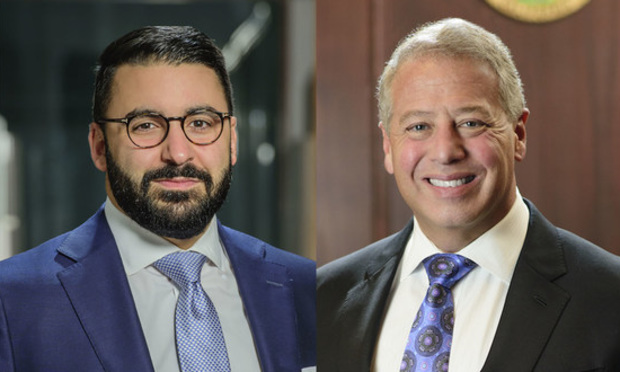How to Get Around the Dreaded Automatic Stay in Bankruptcy
For lawyers dismayed by the utility's bankruptcy filing or facing their own instances where a defendant has become a debtor amid litigation, there are ways to prevent an automatic stay from derailing your clients' civil cases for years.
February 08, 2019 at 11:36 AM
5 minute read
 Shant A. Karnikian (left) Brian Kabateck. (Courtesy photos)
Shant A. Karnikian (left) Brian Kabateck. (Courtesy photos)
Pacific Gas & Electric Co. recently sought bankruptcy protection in the face of more than $30 billion in potential liability from the wildfires that have ravaged California.
One immediate effect the company's Chapter 11 filing had was the halting of thousands of lawsuits and other claims for compensation pending against PG&E lodged by a wide array of victims. In bankruptcy parlance, the pause is known as an “automatic stay,” and it also extends to pending and future litigation filed against a debtor while the bankruptcy process is ongoing. But for lawyers dismayed by the utility's bankruptcy filing or facing their own instances where a defendant has become a debtor amid litigation, there are ways to prevent an automatic stay from derailing your clients' civil cases for years.
A plaintiff with a pending lawsuit against a defendant going through bankruptcy can move to have the automatic stay lifted if they have cause. (11 U.S.C. §362(d)(1).)
The decision concerning whether relief from a stay is granted is “within the broad discretion of the bankruptcy court.” (Truebro, Inc. v. Plumberex Specialty Prods., Inc. (In re Plumberex Specialty Prods., Inc.) (C.D. Cal. 2004) 311 B.R. 551, 558).
And the Ninth Circuit has ruled that stay relief may be ordered to allow litigation pending in another forum to proceed to its conclusion. (See, e.g., Packerland Packing Co. v. Griffith Beverage Co. (In re Kimble) (9th Cir. 1985) 776 F.2d 802, 807.)
The purpose of this allowance—and one of the purposes of bankruptcy in general—is to permit the court and the trustee for the debtor to determine the value of all claims by creditors against the debtor.
As for what constitutes cause for lifting a stay, the Ninth Circuit has decreed that “discretionary relief from the stay must be determined on a case by case basis.” (MacDonald v. MacDonald (In re MacDonald) (9th Cir. 1985) 755 F.2d 715, 717; see also Baldino v. Wilson (In re Wilson) (3d Cir. 1997) 116 F.3d 87, 90.)
To help make such a determination, courts typically consider a set of 12 factors, known as the Curtis factors, derived from In re Curtis, 40 B.R. 795, 799-800 (Bankr. D. Utah 1984) (See also In re Plumberex Specialty Products, Inc., 311 B.R. 551, 560 (Bankr. C.D. Cal. 2004)).
The 12 factors are:
- Whether relief would result in partial or complete issue resolution;
- The lack of any connection with or interference with the bankruptcy case;
- Whether the other proceeding involves the debtor as a fiduciary;
- Whether a specialized tribunal with necessary expertise has been established to hear cause of action;
- Whether the debtor's insurer has assumed full defense responsibility;
- Whether the action primarily involves third parties;
- Whether the litigation in another forum would prejudice the interests of other creditors;
- Whether the judgment claim arising from the other action is subject to equitable subordination;
- Whether movant's success in the other proceeding would result in a judicial lien avoidable by debtor;
- The interests of judicial economy and expeditious and economical resolution of litigation;
- Whether parties are ready for trial in the other proceeding; and
- The impact of the stay on parties and balance of harms.
The factors are non-exclusive, and a court is not required to give each factor equal weight. Plumberex, 311 B.R. at 560.
The court in Curtis said, “[t]he most important factor in determining whether to grant relief from the automatic stay to permit litigation against the debtor in another forum is the effect of such litigation on the administration of the estate.”
Lawyers seeking to have a motion for a lifting of an automatic stay granted are most likely to be successful when they can demonstrate more of the applicable Curtis factors weigh in their favor than those that do not.
If a bankruptcy court denies your motion, you have the option of appealing to a district court and the potential for an order determining the bankruptcy court abused its discretion. In re Roger, No. 5:14-cv-02515, (C.D. Cal. 2015)
Additionally, plaintiffs' lawyers should be aware that an automatic stay does not protect non-bankrupt third parties even when they are closely related to the debtor. (U.S. v. Dos Cabezas Corp. (9th Cir. 1993) 995 F.2d 1486, 1491) The nonbankrupt third parties would include co-defendants that your client may have a claim against. California courts have also held that bankruptcy of one defendant in a case with multiple defendants does not stay the proceeding as to the other defendants. Queenie, Ltd. v. Nygard Int'l (2nd Cir. 2003) 321 F3d 282, 287; In re Miller (9th Cir. BAP 2001) 262 BR 499, 503-504 & fn. 6; Fortier v. Dona Anna Plaza Partners (10th Cir. 1984) 747 F2d 1324, 1329-1330.
While there are many obstacles created when a defendant files for bankruptcy, plaintiffs should not be discouraged. By following the proper procedure and brushing up on relevant case law, relief from an automatic stay can be obtained. This would give the plaintiff the opportunity to proceed against the debtor defendant in civil court and ultimately obtain a well-deserved judgment.
Brian S. Kabateck is a consumer rights attorney and founder of Kabateck LLP in Los Angeles. He represents plaintiffs in personal injury lawsuits, mass torts litigation, class actions, insurance bad faith lawsuits, insurance litigation and commercial contingency litigation.
Shant A. Karnikian is a senior associate at Kabateck LLP. His practice focuses on consumer class actions, insurance bad faith, and personal injury.
This content has been archived. It is available through our partners, LexisNexis® and Bloomberg Law.
To view this content, please continue to their sites.
Not a Lexis Subscriber?
Subscribe Now
Not a Bloomberg Law Subscriber?
Subscribe Now
NOT FOR REPRINT
© 2025 ALM Global, LLC, All Rights Reserved. Request academic re-use from www.copyright.com. All other uses, submit a request to [email protected]. For more information visit Asset & Logo Licensing.
You Might Like
View All
No Two Wildfires Alike: Lawyers Take Different Legal Strategies in California
5 minute read
Holland & Knight Hires Former Davis Wright Tremaine Managing Partner in Seattle
3 minute read
ExxonMobil Sues California AG Bonta, Environmental Groups for Advanced Recycling 'Smear Campaign'

Litigators of the Week: A $604.9M Trade Secrets Verdict With a Big Assist From a Juror Question
Trending Stories
- 1LexisNexis Announces Public Availability of Personalized AI Assistant Protégé
- 2Some Thoughts on What It Takes to Connect With Millennial Jurors
- 3Artificial Wisdom or Automated Folly? Practical Considerations for Arbitration Practitioners to Address the AI Conundrum
- 4The New Global M&A Kings All Have Something in Common
- 5Big Law Aims to Make DEI Less Divisive in Trump's Second Term
Who Got The Work
J. Brugh Lower of Gibbons has entered an appearance for industrial equipment supplier Devco Corporation in a pending trademark infringement lawsuit. The suit, accusing the defendant of selling knock-off Graco products, was filed Dec. 18 in New Jersey District Court by Rivkin Radler on behalf of Graco Inc. and Graco Minnesota. The case, assigned to U.S. District Judge Zahid N. Quraishi, is 3:24-cv-11294, Graco Inc. et al v. Devco Corporation.
Who Got The Work
Rebecca Maller-Stein and Kent A. Yalowitz of Arnold & Porter Kaye Scholer have entered their appearances for Hanaco Venture Capital and its executives, Lior Prosor and David Frankel, in a pending securities lawsuit. The action, filed on Dec. 24 in New York Southern District Court by Zell, Aron & Co. on behalf of Goldeneye Advisors, accuses the defendants of negligently and fraudulently managing the plaintiff's $1 million investment. The case, assigned to U.S. District Judge Vernon S. Broderick, is 1:24-cv-09918, Goldeneye Advisors, LLC v. Hanaco Venture Capital, Ltd. et al.
Who Got The Work
Attorneys from A&O Shearman has stepped in as defense counsel for Toronto-Dominion Bank and other defendants in a pending securities class action. The suit, filed Dec. 11 in New York Southern District Court by Bleichmar Fonti & Auld, accuses the defendants of concealing the bank's 'pervasive' deficiencies in regards to its compliance with the Bank Secrecy Act and the quality of its anti-money laundering controls. The case, assigned to U.S. District Judge Arun Subramanian, is 1:24-cv-09445, Gonzalez v. The Toronto-Dominion Bank et al.
Who Got The Work
Crown Castle International, a Pennsylvania company providing shared communications infrastructure, has turned to Luke D. Wolf of Gordon Rees Scully Mansukhani to fend off a pending breach-of-contract lawsuit. The court action, filed Nov. 25 in Michigan Eastern District Court by Hooper Hathaway PC on behalf of The Town Residences LLC, accuses Crown Castle of failing to transfer approximately $30,000 in utility payments from T-Mobile in breach of a roof-top lease and assignment agreement. The case, assigned to U.S. District Judge Susan K. Declercq, is 2:24-cv-13131, The Town Residences LLC v. T-Mobile US, Inc. et al.
Who Got The Work
Wilfred P. Coronato and Daniel M. Schwartz of McCarter & English have stepped in as defense counsel to Electrolux Home Products Inc. in a pending product liability lawsuit. The court action, filed Nov. 26 in New York Eastern District Court by Poulos Lopiccolo PC and Nagel Rice LLP on behalf of David Stern, alleges that the defendant's refrigerators’ drawers and shelving repeatedly break and fall apart within months after purchase. The case, assigned to U.S. District Judge Joan M. Azrack, is 2:24-cv-08204, Stern v. Electrolux Home Products, Inc.
Featured Firms
Law Offices of Gary Martin Hays & Associates, P.C.
(470) 294-1674
Law Offices of Mark E. Salomone
(857) 444-6468
Smith & Hassler
(713) 739-1250






